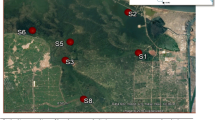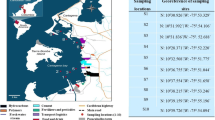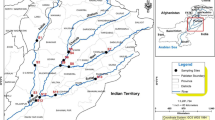Abstract
This study aimed to compare the contamination levels of various organohalogenated compounds in two migratory fish species in the Vilaine River in western France. Organochlorinated pesticides, polychlorinated biphenyls (PCBs), dioxins (polychlorinated dibenzo-p-dioxins/dibenzofurans (PCDDs/Fs)), and polybrominated diphenyl ethers (PBDEs) were analyzed in two diadromous species from the Vilaine estuary, the grey mullet (Liza ramada)—an amphihaline species, and the allis shad (Alosa alosa)—an anadromous species. Fish were collected in spring 2004 and spring 2005, upstream and downstream of the Arzal Dam. PCB contamination varied from 27 to 200 ng g−1 dry weight (d.w.). PCDDs/Fs, expressed in toxicity equivalent quantity (TEQ) varied from 0.4 to 2.8 pg g−1 d.w. Dioxins and dioxin-like PCBs expressed in total TEQ varied from 1.4 to 18.8 pg g−1 d.w. PBDE47 was present at around 2–10 ng g−1 d.w. and concentrations of the insecticide dichlorodiphenyltrichloroethane breakdown product p,p′-dichlorodiphenylchloroethylene varied from 1 to 14 ng g−1 d.w. For both species, specimens collected upstream were more contaminated. The grey mullet specimens were less contaminated than the allis shad when taken downstream of the dam but were more contaminated upstream. The allis shads presented intermediate contaminant concentrations with a less pronounced difference between upstream and downstream specimens. However, it is thought that shads do not feed when they spawn in the upstream parts of rivers, which should modify the contaminant concentrations. However, measurements in upstream shad samples show an unexpected increase of the contamination, which remains unexplained.


Similar content being viewed by others
References
Almeida PR (2003) Feeding ecology of Liza ramada (Risso, 1810) in a south-western estuary of Portugal. Estuar Coast Shelf Sci 57:313–323
Almeida PR, Moreira F, Costa JL, Assis CA, Costa MJ (1993) The feeding strategy of Liza ramada (Risso, 1826) in fresh and brackish water in the river Tagus, Portugal. J Fish Biol 42:95–107
Anonymous (2006) Commission Regulation (E.C.) No 1881/2006 of 19 December 2006 setting maximum levels for certain contaminants in foodstuffs. Offic J Eur Union 20.12.2006 L 364, p. 5
Anonymous (2011) Commission regulation (E.C.) No 1259/2011 of 2 December 2011 amending Regulation (EC) No 1881/2006 as regards maximum levels for dioxins, dioxin-like PCBs and non dioxin-like PCBs in foodstuffs. Offic J Eur Union 3.12.2011 L 320 p. 18
Babut M, Miège C (2007) Contamination of fish and sediments by PCBs in the Rhone River (France). Data collected in 2005–2006. In: Cémagref/Préfecture du Rhône report. Dir Citoyen Environ, p. 36 (in French)
Bachelet D, Truong T, Verner MA, Arveux P, Kerbrat P, Charlier C, Guihenneuc-Jouyaux C, Guénel P (2011) Determinants of serum concentrations of 1,1-dichloro-2,2-bis (p-chlorophenyl) ethylene and polychlorinated biphenyls among French women in the CECILE study. Environ Res 111:861–870
Baglinière JL (2000) The genus Alosa. In: Baglinière JL, Elie P (ed) The shads (Alosa alosa and Alosa fallax spp.): ecobiology and diversity of populations. Paris Inra-Cémagref, pp. 3–30 (in French)
Baglinière JL, Sabatié MR, Aprahamian MW, Alexandrino P, Aprahamian CD, Assis CA, Cassou-Leins JJ, Le Corre M, Mennesson-Boisneau C, Martin-Vandembulcke D, Rochard E, Teixeira C (2001) Guide for interpretation of scales and assessment of age in the shads (Alosa alosa) from the French East-Atlantic shore and French West-Mediterranean Sea. Bull Fr Pêche Piscic 357–360:485–531 (in French)
Baglinière JL, Sabatié MR, Rochard E, Alexandrino P, Aprahamian MW (2003) The allis shad Alosa alosa: biology, ecology, range and status of populations. In: Limburg KE, Waldman JR (eds) Biodiversity, status, and conservation of the world’s shads. Am Fish Soc Sym, Bethesda, pp 85–102
Birnbaum LS, Staskal-Wikoff DS (2010) 5th international PCB workshop—summary and implications. Environ Int 36:814–818
Bracken J, Kennedy M (1967) Notes on some Irish estuarine and inshores fishes. Ir Fish Investig, Ser B (Marine), No. 3, pp. 28
Bruslé J (1981) Food and feeding in grey mullets. In: Oren EH (ed) Aquaculture of grey mullets. Cambridge University Press, Cambridge, pp 185–217
Johansson II, Héas-Moisan K, Guiot N, Truquet I, Munschy C, Tronczyński J (2006) Polybrominated diphenyl ethers (PBDEs) in mussels from selected French coastal sites: 1981–2003. Chemosphere 64(2):296–305
King JJ, Roche WK (2008) Fish and diadromy in Europe. Aspects of anadromous allis shad (Alos alosa) and twaite shad (Alosa fallax) biology in four Irish Special Areas of Conservation (SACs): status, spawning indications and implication for conservation designation. Hydrobiologia 602:145–154
Law R, Allchin J, Colin R, de Boer J, Covaci A, Herzke D, Lepom P, Morris S, Tronczynski J, de Wit CA (2005) Levels and trends of brominated flame retardants in the European environment. Chemosphere 64(2):187–208
Leblanc JC, coord. (2006) CALIPSO fish and seafood consumption study and biomarker of exposure to trace elements, pollutants and omega3. Afssa/Dgal/Inra. p. 160
Lochet A, Maury-Brachet R, Poirier C (2008) Mercury contamination and life history traits of allis shad Alosa alosa (Linnaeus, 1758) and Twaite shad Alosa fallax (Lacépède, 1803) in the Gironde estuary (South West France). Hydrobiol 602:99–109
Loizeau L, Abarnou A (1994) Distribution of polychlorinated biphenyls in dab (Limanda limanda) from the Baie de Seine. Mar Environ Res 38:77–91
Mennesson-Boisneau C, Aprahamian MW, Sabatié MR, Cassou-Leins JJ (2000a) Adult characterization. In: Baglinière JL, Elie P (ed) The shads (Alosa alosa and Alosa fallax spp.): ecobiology and diversity of populations, ecobiology and diversity of populations. Paris Inra-Cémagref, pp. 33–54 (in French)
Mennesson-Boisneau C, Aprahamian MW Sabatié MR Cassou-Leins J-J (2000b) Upstream migration of adults. In: Baglinière JL, Elie P (ed) The shads (Alosa alosa and Alosa fallax spp.): ecobiology and diversity of populations. Paris Inra-Cémagref, pp. 55–72 (in French)
Morgan EJ, Lohman R (2010) Dietary uptake from historically contaminated sediments as a source of PCBs to migratory fish and invertebrates in an urban estuary. Environ Sci Technol 44:5444–5449
Pastel M, Bush B, Kim JS (1980) Accumulation of polychlorinated biphenyls in American shad during their migration in the Hudson River, spring 1977. Pestic Monit J 14(1):11–22
Sabatié MR (1993) Research on biology and ecology of shads (Alosa alosa and Alosa fallax) in Morocco. Dissertation, University of Bretagne Occidentale, France (in French)
Sauriau PG, Marchand J Goinard N (1994) Summer mortality of the grey mullet Liza ramada in the Loire estuary: synthetic report. In: Asso. Protect. Environ. Loire Estuary. 1984–1994 pp. 47–59 (in French)
Schnitzler JG, Thomé JP, Lepage M, Das K (2011) Organochlorine pesticides, polychlorinated biphenyls and trace elements in wild European sea bass (Dicentrarchus labrax) of European estuaries. Sci Total Environ 409:3680–3686
Sellstrom U, Bignert A, Kierkegaard A, Haggberg L, de Wit CA, Olsson M, Jansson B (2003) Temporal trend studies on tetra- and pentabrominated diphenyl ethers and hexabromo-cyclododecane in guillemot egg from the Baltic Sea. Environ Sci Technol 37(24):5496–5501
Taverny C (1991) Contribution to the knowledge of the population dynamics of shads in the estuarine waters of the Gironde river (France), Dissertation, University of Bordeaux I, France (in French)
Van den Berg M, Birnbaum L, Bosveld AT et al (1998) Toxic equivalency factors (TEFs) for PCBs, PCDDs, PCDFs for humans and wildlife. Environ Health Perspect 106:775–792
Van den Berg M, Birnbaum LS, Denison M et al (2006) The 2005 World Health Organization reevaluation of human and mammalian toxic equivalency factors for dioxins and dioxin-like compounds. Toxic Sci 93(2):223–241
Van Geest JL, Mackay D, Poirier DG (2011) Accumulation and depuration of polychlorinated biphenyls from field-collected sediment in three freshwater organisms. Environ Sci Technol 45:7011–7018
Yogui GT, Sericano JL (2009) Polybrominated diphenyl ether flame retardants in the U.S. marine environment. A review. Environ Int 35:655–666
Author information
Authors and Affiliations
Corresponding author
Additional information
Responsible editor: Leif Kronberg
Rights and permissions
About this article
Cite this article
Bocquené, G., Abarnou, A. Organochlorinated pesticides, PCBs, dioxins, and PBDEs in grey mullets (Liza ramada) and allis shads (Alosa alosa) from the Vilaine estuary (France). Environ Sci Pollut Res 20, 667–675 (2013). https://doi.org/10.1007/s11356-012-1206-4
Received:
Accepted:
Published:
Issue Date:
DOI: https://doi.org/10.1007/s11356-012-1206-4




